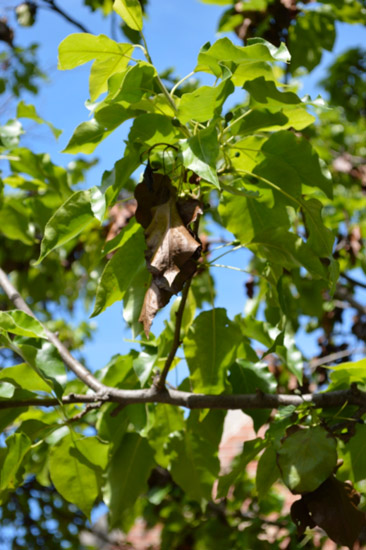Issue 4, May 14, 2012
Bacterial Blight of Callery Pear
This spring, many Callery pears in Illinois are showing symptoms of Bacterial blight, a disease caused by Pseudomonas syringe. This is a weak pathogen known to infect many species of ornamentals, especially when the plants are under stress. Like many bacterial pathogens, it requires a wound or natural opening to enter the plant. Pseudomonas syringe is quite common in the environment and can inhabit plants without causing disease symptoms. When symptoms of bacterial blight do occur, they are often seen as: leaf spots, leaf blight, bud blight, blossom blight, shoot blight and cankers. Symptoms of bacterial blight are commonly mistaken for frost damage or fire blight. Laboratory analysis may be required to determine the true cause of the symptoms.

Leaf blight caused by Pseudomonas syringae on Callery pear

Leaf blight caused by Pseudomonas syringae on Callery pear

Pseudomonas syringae fluorescing under a black light. Bacterial blight and Fire blight (Erwinia amylavora) can be distinguished from each other using a specialized agar. Unlike the fire blight bacterium, Pseudomonas will fluoresce, providing a useful diagnostic tool.
This year's odd spring weather likely contributed to occurrence of this disease. Several frosts occurred after the Callery pears had leafed out. Frost has been known to predispose plants to infection by Pseudomonas syringae. Damage from frost may be more severe when associated with a Psedomonas infection. There are strains of this bacterium that can aid ice nucleation, or ice crystal formation, within plant cells. Essentially, most plants can tolerate brief periods of cooling at temperatures just below freezing. Plants which would normally be unharmed by brief cold temperatures may have frost damage occur when infected with Pseudomonas syringae. Bacterial pathogens have also been known to rapidly increase in host tissues affected by frost.
Control options include the following:
- Avoid high nitrogen applications that produce great quantities of succulent growth in spring or fall. This tissue is most likely to be injured by frost, sudden weather changes, wind, etc; and injured tissue is most susceptible to bacterial infection. Fertilization is a good thing, but it should be balanced and not excessive.
- Some research in nurseries has shown that pruning trees in the fall and early winter actually increases their subsequent infection by Pseudomonas syringae. The suggestion is to prune in January or February. As with fire blight management, prune only in dry weather and be certain to disinfect clippers between cuts with a disinfectant such as 10% Clorox.
- There is current research with the goal of developing plant cultivars resistant to this bacterial pathogen. Look for mention of such resistance when looking for plants for your landscape.
- Fixed copper fungicides have been tried with varying success in nurseries with production problems caused by Pseudomonas syringae. The compounds are used in the fall to kill the overwintering bacterium before winter injury occurs. Homeowner use of such compounds has not yet been advocated.
(Travis Cleveland)
Author:
Travis Cleveland